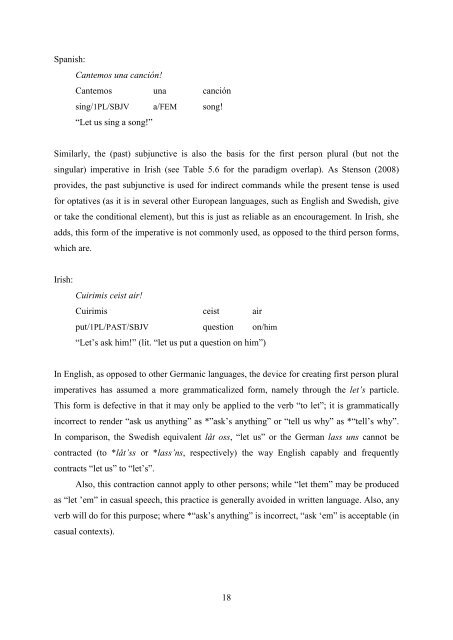The function of non-canonical imperatives in the languages of Europe
The function of non-canonical imperatives in the languages of Europe
The function of non-canonical imperatives in the languages of Europe
You also want an ePaper? Increase the reach of your titles
YUMPU automatically turns print PDFs into web optimized ePapers that Google loves.
Spanish:<br />
Cantemos una canción!<br />
Cantemos una canción<br />
s<strong>in</strong>g/1PL/SBJV a/FEM song!<br />
“Let us s<strong>in</strong>g a song!”<br />
Similarly, <strong>the</strong> (past) subjunctive is also <strong>the</strong> basis for <strong>the</strong> first person plural (but not <strong>the</strong><br />
s<strong>in</strong>gular) imperative <strong>in</strong> Irish (see Table 5.6 for <strong>the</strong> paradigm overlap). As Stenson (2008)<br />
provides, <strong>the</strong> past subjunctive is used for <strong>in</strong>direct commands while <strong>the</strong> present tense is used<br />
for optatives (as it is <strong>in</strong> several o<strong>the</strong>r <strong>Europe</strong>an <strong>languages</strong>, such as English and Swedish, give<br />
or take <strong>the</strong> conditional element), but this is just as reliable as an encouragement. In Irish, she<br />
adds, this form <strong>of</strong> <strong>the</strong> imperative is not commonly used, as opposed to <strong>the</strong> third person forms,<br />
which are.<br />
Irish:<br />
Cuirimis ceist air!<br />
Cuirimis ceist air<br />
put/1PL/PAST/SBJV question on/him<br />
“Let’s ask him!” (lit. “let us put a question on him”)<br />
In English, as opposed to o<strong>the</strong>r Germanic <strong>languages</strong>, <strong>the</strong> device for creat<strong>in</strong>g first person plural<br />
<strong>imperatives</strong> has assumed a more grammaticalized form, namely through <strong>the</strong> let’s particle.<br />
This form is defective <strong>in</strong> that it may only be applied to <strong>the</strong> verb “to let”; it is grammatically<br />
<strong>in</strong>correct to render “ask us anyth<strong>in</strong>g” as *”ask’s anyth<strong>in</strong>g” or “tell us why” as *“tell’s why”.<br />
In comparison, <strong>the</strong> Swedish equivalent låt oss, “let us” or <strong>the</strong> German lass uns cannot be<br />
contracted (to *låt’ss or *lass’ns, respectively) <strong>the</strong> way English capably and frequently<br />
contracts “let us” to “let’s”.<br />
Also, this contraction cannot apply to o<strong>the</strong>r persons; while “let <strong>the</strong>m” may be produced<br />
as “let ’em” <strong>in</strong> casual speech, this practice is generally avoided <strong>in</strong> written language. Also, any<br />
verb will do for this purpose; where *“ask’s anyth<strong>in</strong>g” is <strong>in</strong>correct, “ask ‘em” is acceptable (<strong>in</strong><br />
casual contexts).<br />
18
















